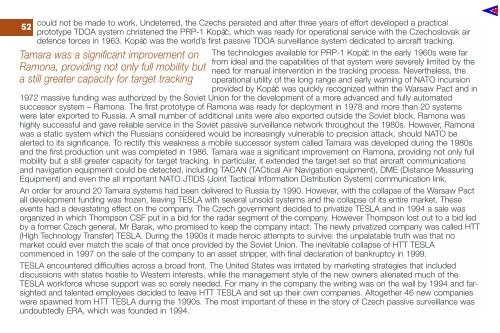Volume 5 No 2 - Royal Air Force Centre for Air Power Studies
Volume 5 No 2 - Royal Air Force Centre for Air Power Studies
Volume 5 No 2 - Royal Air Force Centre for Air Power Studies
Create successful ePaper yourself
Turn your PDF publications into a flip-book with our unique Google optimized e-Paper software.
52<br />
could not be made to work. Undeterred, the Czechs persisted and after three years of ef<strong>for</strong>t developed a practical<br />
prototype TDOA system christened the PRP-1 Kopà˘c, which was ready <strong>for</strong> operational service with the Czechoslovak air<br />
defence <strong>for</strong>ces in 1963. Kopà˘c was the world’s first passive TDOA surveillance system dedicated to aircraft tracking.<br />
Tamara was a significant improvement on<br />
Ramona, providing not only full mobility but<br />
a still greater capacity <strong>for</strong> target tracking<br />
The technologies available <strong>for</strong> PRP-1 Kopà˘c in the early 1960s were far<br />
from ideal and the capabilities of that system were severely limited by the<br />
need <strong>for</strong> manual intervention in the tracking process. Nevertheless, the<br />
operational utility of the long range and early warning of NATO incursion<br />
provided by Kopà˘c was quickly recognized within the Warsaw Pact and in<br />
1972 massive funding was authorized by the Soviet Union <strong>for</strong> the development of a more advanced and fully automated<br />
successor system – Ramona. The first prototype of Ramona was ready <strong>for</strong> deployment in 1978 and more than 20 systems<br />
were later exported to Russia. A small number of additional units were also exported outside the Soviet block. Ramona was<br />
highly successful and gave reliable service in the Soviet passive surveillance network throughout the 1980s. However, Ramona<br />
was a static system which the Russians considered would be increasingly vulnerable to precision attack, should NATO be<br />
alerted to its significance. To rectify this weakness a mobile successor system called Tamara was developed during the 1980s<br />
and the first production unit was completed in 1986. Tamara was a significant improvement on Ramona, providing not only full<br />
mobility but a still greater capacity <strong>for</strong> target tracking. In particular, it extended the target set so that aircraft communications<br />
and navigation equipment could be detected, including TACAN (TACtical <strong>Air</strong> Navigation equipment), DME (Distance Measuring<br />
Equipment) and even the all important NATO JTIDS (Joint Tactical In<strong>for</strong>mation Distribution System) communication link.<br />
An order <strong>for</strong> around 20 Tamara systems had been delivered to Russia by 1990. However, with the collapse of the Warsaw Pact<br />
all development funding was frozen, leaving TESLA with several unsold systems and the collapse of its entire market. These<br />
events had a devastating effect on the company. The Czech government decided to privatize TESLA and in 1994 a sale was<br />
organized in which Thompson CSF put in a bid <strong>for</strong> the radar segment of the company. However Thompson lost out to a bid led<br />
by a <strong>for</strong>mer Czech general, Mr Barak, who promised to keep the company intact. The newly privatized company was called HTT<br />
(High Technology Transfer) TESLA. During the 1990s it made heroic attempts to survive: the unpalatable truth was that no<br />
market could ever match the scale of that once provided by the Soviet Union. The inevitable collapse of HTT TESLA<br />
commenced in 1997 on the sale of the company to an asset stripper, with final declaration of bankruptcy in 1999.<br />
TESLA encountered difficulties across a broad front. The United States was irritated by marketing strategies that included<br />
discussions with states hostile to Western interests, while the management style of the new owners alienated much of the<br />
TESLA work<strong>for</strong>ce whose support was so sorely needed. For many in the company the writing was on the wall by 1994 and farsighted<br />
and talented employees decided to leave HTT TESLA and set up their own companies. Altogether 46 new companies<br />
were spawned from HTT TESLA during the 1990s. The most important of these in the story of Czech passive surveillance was<br />
undoubtedly ERA, which was founded in 1994.
















